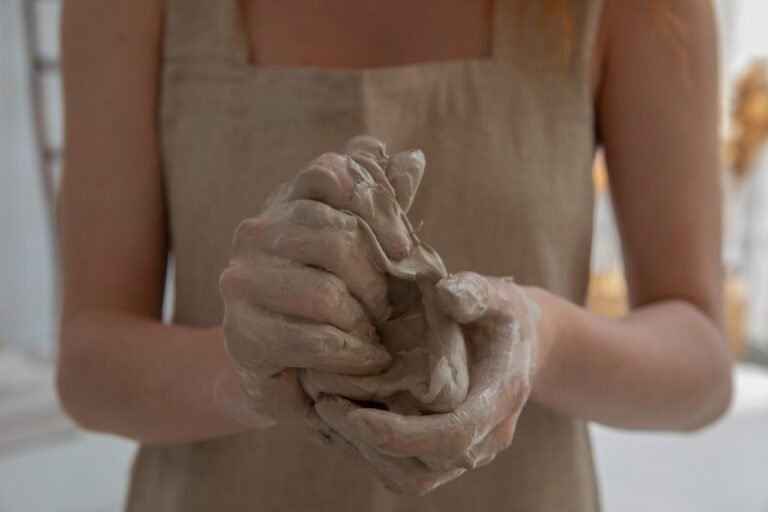Why is Pottery Called Throwing Clay? Quick Facts!
Pottery is an ancient craft that dates back as early as 29,000-25,000 BC. Pottery is the art and process of molding clay and ceramics into objects and vessels. What many people do not know is that pottery has an array of unusual terms. In this article, I’d be shedding more light on why pottery is called throwing clay.
Pottery is called throwing clay because the Old English word thrawan, from which to throw originates, means to twist or turn. Since the activity of molding vessels on the wheel has not changed since the Old English era, the word throw has held on to its original meaning in the language of pottery.
I will delve further into the subject of throwing. This will give you a deeper understanding of the interesting and creative world of pottery.
What Does Throwing Mean In Pottery?
In general, terms, throwing in pottery refers to the process from the time the clay touches the wheel to the time the wheel is stopped. It is a process of forming pottery vessels on a potter’s wheel. Throwing is the entire activity of shaping the clay on the potter’s wheel.
As a specific term, one part of the general activity of throwing is a specific step called THROWING. To throw the clay means to twist it between your finger joints. The right finger is lower than the left. This is important since the difference is what forces the clay to bend.
As the potter’s hands move upward, the clay is extended through the curve, with the excess clay being forced upward. This creates the vessel’s height as well as thinning the walls.
A potter strives to achieve a good throw, not only to make the walls taller and thinner but to also achieve uniformity in thickness from top to bottom. A potter who is new to throwing will have an inconsistent thickness in walls, with a thicker bottom.
You can master the art of molding a uniform wall by throwing with your eyes closed. It will help you focus your attention on the movements of your hands, thereby judging the thickness and consistency of the walls.
People have called throwing by several different terms. The particular act of throwing has sometimes been referred to as pulling up. The overall act of throwing on the wheel has often been called turning. Generally, the most right term is “to throw”.
What Is Throwing Clay On A Wheel?
As I emphasized earlier, throwing clay is the art of placing already wedged clay at the center of a flat wheel. The spinning wheel in collaboration with your hands will form objects of your desire. Throwing clay involves a few steps from start to finish when making a vessel. They are:
- centering the clay,
- opening it up,
- pulling up the walls,
- collaring in the neck of the pot.
Before throwing clay on a wheel, a potter has to prepare it through a process called wedging. Wedging is a method of working on clay to remove air bubbles. Wedging gives even consistency to clay with hard or soft areas before throwing on wheel or molding by the hands.
The potter throws clay onto the wheel head while rotating, and centers the clay (for smooth and even shape) on the wheel forcing it to spin through with the use of hands. By applying force to the clay, a potter uses different methods such as; coning up and down, the clay becomes more central.
Once the clay is centered, the potter begins to open up the clay, creating a hole at the center. Potters can either use their fingers or thumb in opening up the clay. This is done consistently until the base of the clay is 1/3 thick.
With the opening of the vessel, the potter will move the excess clay at the bottom to the sides of the piece to make the walls. This process of moving the clay upwards is called ‘pulling’ the walls. Though it may take a porter a few pulls to get the right height and thickness for the walls.
Depending on the shape and type of vessel, the potter may ‘collar’ in the neck by squeezing in the top edge. This will create a narrow neck for vessels such as vases, jugs, bottles e.t.c.
When the ideal shape has been accomplished, the vessel is removed from the wheel with a string. After the vessel has been left out to harden slightly it is worked further in a process called turning.
Is Throwing Pottery Hard?
As the popular saying goes, nothing good comes easy. Every sustainable craft requires dedication, hard work, and the right attitude. Pottery is no magic no doubt. But if you’ve seen a potter on the wheel transform a mound of clay into a vessel, trust me it’s a captivating sight.
You might be wondering if pottery is easy, or hard. You might be asking yourself, how a newbie like you will face the wheel.
I have some tips that will guide you as a beginner in your pottery journey.
Wear agreeable garments that you wouldn’t fret about getting filthy: Also while starting new; use brown stoneware clay that is easy to wash off clothes.
Anticipate gradual advancement: Do not set high expectations for yourself. Slow and steady does it, to avoid disappointments and having to throw in the towel.
Do not be irritable with dirt: When it’s time for clean-up, do it with some excitement. After all, it’s your mess.
Try to enjoy the experience: Don’t get yourself stressed. You must relax while at the wheel.
Praise your little triumphs: Pat yourself on the back for every success you make, no matter how little. It’s a sign that you’re growing.
If you are ready to give pottery a trial, then I propose you take a class. You can also watch this YouTube video for self-learning.







